动词(非谓语动词3
动词的非谓语形式有三种

动词的非谓语形式有三种:不定式、动名词和分词。
一、不定式由“to+动词原形”构成,其否定形式是“not to do”。
不定式可以带宾语或状语构成不定式短语。
不定式没有人称和数的变化,有时态和语态的变化。
不定式可以作主语、宾语、状语、表语和定语。
不定式复合结构为“介词+sb.(sth.)+to do”,其中“介词+sb.(sth.)”表明不定式动作的发出者,为逻辑主语。
1. 不定式的用法:(1)作主语。
不定式短语作主语时,为了使句子结构平衡,常将不定式短语放在谓语之后,而用it作形式主语。
It is our duty to give as much help as possible. 提供尽可能多的帮助是我们的职责。
但不定式作表语时,前面有不定式作主语,不定式不可位于句末。
如:To see is to believe. 眼见为实。
(2)作宾语。
常见的只跟不定式作宾语的动词(组)有want, wish, hope, expect, would like (love),care, choose, learn, plan, prepare, mean, agree, promise, offer, refuse, ask, beg, decide, make up one’s mind, be determined, manage, try, can’t afford, fail, pretend等。
He promised to come today, but he hasn’t turned up yet .No one likes to be laughed at. 没人喜欢被嘲笑。
有形容词、分词、名词作宾补,不定式作宾语时要将不定式放于句末,用it 来作形式宾语。
如:You may find it necessary to finish the work ahead of time. 你会发现有必要提前完成工作。
非谓语动词有3种形式

非谓语动词有3种形式:不定式、动名词和分词Ⅰ不定式具有名词、形容词和副词的性质一作主语1.To see is to believe.2. It’s difficult (for us) to learn English.3. It’s foolish of h er to believe him.= She is foolish to believe him.二作表语1. His aim is to win the first prize.2. All we can do is (to) wait.One’s dream / aim / ambition / wish / The first step / What I want to do is to…三作宾语1. He demanded to be told the truth.2. He pretended to be doing his homework / to have fallen asleep when Mother came in.(decide / fail / manage / refuse / pretend / choose / agree / hope/ plan / promise / make up one’s mind + to do)3.I don’t know what to do.(decide / find out / know / learn / consider etc + 疑问词+ to do)4. Anyone can become a better scholar if he wants to.5. ---Are you on holiday? ---No, but I’d like to be.四作宾补或主补1. I’ll have him say something at the meeting.have sb do = get sb to dofeel; hear / listen to; let / have / make; see / watch / look at / notice / observe sb do但被动语态要+ to, let 例外Listen to me read the text.He is often listened to to sing the song.He was let go by the police.2. He ordered his men to fire.wish / advise / persuade / allow / permit / want / tell / ask / expect / order / require / request sb to dosuggest / hope / agree / demand / arrange sb to do3. He is said to be doing the work of next year.It’s said that he is doing the work of next year.sb + seem / appear / happen / be said / be reported / be known /be found / be believed + to do / to be doing / to have ( been) doneIt + seem / appear / happen / be said … / be believe that….六作定语1. I have a lot of work to do / no pen to write with.2. the first to come / to be awarded the Nobel Prize3. the last person to do such a thing 最不愿意做…的人4. the house to be built next year比较: the house being built now / build last year七作状语(目的、原因、结果或条件)目的to / in order to / so as to结果enough to / too…to / so…as to / such…as to / only to1. The bus stopped to pick up passengers.2. He set out early in order to / so as to catch the first bus.= In order to / To catch the first bus he set out early.3. I’m sorry to have kept you waiting.4. I hurried to school only to be told it was a holiday.only to do sth 表示出于预料之外的结果不定式的否定形式She kept silent about the accident so as not to lose his job.不定式的完成和被动式The book seems to have been translated into English.但是: The book is difficult to understand.I have a letter to write / a lot of work to do.He is to blame for the accident.Ⅱ动名词具有名词的性质一作主语1. Seeing is believing. = To see is to believe.2. It’s no use / no good / useless doing sth. It’s no use crying over spilt milk.3. Being forced to leave the classroom made him feel embarrassed.二作表语1. My job is teaching English.比较: One’s dream / aim / ambition / The first step is to do sth.动名词作表语, 可与主语交换位置, 句子成立; 现在分词则不能。
动词的非谓语形式有三种不定式动名和分词

注①
admit,appreciate,avoid,consider, delay, dislike,enjoy,escape, excuse,face,feel like,finish,forgive,give up, imagine,include,keep,mention,mind,miss,practise,put off,resist, risk,suggest,can’t help,can’t stand(无法忍受)等动词后可以用动名词作宾语,但不能用不定式.
2
动名词的复合结构同由
物主代词
人称代词宾格 +动名词 构成
名词所有格
普通格加
2
2.动名词的复合结构
句子开头必须用名词所有格或物主代词.
例如: His coming made me very happy. Mary’s crying annoyed him. She didn't mind his crying. Is there any hope for Xiao Wang’s winning?
但在 It is no use/ good,not any use/ good,useless /there is no …等后必须用动名词。 例如:
01
02
2)作表语.
例如: Her job is teaching.
He is fond of playing football.
01
I like swimming.
I must remember to do it. (我必须记着做这事.) I tried not to go there. (我没法不去那里. He stopped to talk. (他停下来讲话.) I mean to come early today. (我打算今早些来.)
动词的非谓语形式

动词的非谓语形式:动词不做谓语时的固定形式。
(1) 动词的非谓语形式包括动词不定式、动名词和分词三种形式;其中分词又包含现在分词和过去分词两种形式。
它们在句子中不能单独作谓语。
(2) 动词不定式:①形式:动词不定式基本形式由“不定式记号to+动词原形”构成。
它的否认形式只要在“to” 前面加上“not”。
它的疑问形式是:“wh-疑问词+to+动词原形”。
*它的被动形式:“to be +过去分词”。
*它的完成形式:“to have +过去分词”。
②动词不定式具有名词、形容词和副词的特征,即可以在句子中作主语、宾语、定语、状语、表语和宾语补足语。
但不定式也保留动词的某些特征,即不定式后面可以跟宾语、表语和状语。
动词不定式加上相关成分就构成不定式短语。
③动词不定式可以放在谓语前句子作主语。
但是通常将作主语的动词不定式或不定式短语放在谓语后面,而在主语位置用“it”作形式主语(有时在不定式的前面还会用for sb.表示不定式的逻辑主语)。
如:To help animals is helping people.(帮助动物就是帮助人)/ It is very difficult (for us) to learn Chinese well.((对于我们而言)学好汉语是非常的困难)/ It took me half an hour to work out this problem.(解出这道题花了我一个小时的时间)④动词不定式可以作谓语动词(及物动词)的宾语。
[A] 及物动词+不定式一般形式:如:I would like to have a rest at the moment.(我现在想休息一下)/ They began to search the room for the thief.(他们开始在屋子里搜寻小偷)/ He liked to have aswim in the pool near his house.(他喜爱在靠家的水塘里面游泳)/ When did you learn to speak English?(你什么时候开始学英语的?)/ Don’t forget to close the door when you leave.(你离开时别忘了关门)[比较] He forgot to turn off the light.(他忘了关灯.) (没关)/ He forgot turning off the light.(他忘记关过灯.)(关了) / Please remember to ring me up.(记得给我打.)(还没打) / I remember calling you yesterday but you forgot.(我记得昨天给你打了,但是你忘记了.)(打过)[B] 及物动词+疑问词+不定式:如:He does not know which one to take.(他不知道该选哪个)/ Tell me how to get to the station.(告诉我怎么样去火车站)/ She asked me what to do for today’s homework.(她问我今天家庭作业做什么)/ Can you teach me how to search the internet?(你能教我怎样上网吗?)[C] 不定式作宾语而后面又有宾语补足语时,通常用it代替作形式宾语,而不定式则后置。
动词的非谓语形式有三种

动词的非谓语形式有三种————————————————————————————————作者:————————————————————————————————日期:ﻩ动词的非谓语形式有三种:不定式、动名词和分词(一)不定式不定式由“ to十动词原形”构成,其否定形式是“ nottodo”.不定式可以带宾语或状语构成不定式短语,没有人称和数的变化,但有时态和语态的变化.不定式可作主语、宾语、状语、表语和定语,但不能单独作谓语.不定式的逻辑主语有时用“for十名词或代词宾格”构成.1.不定式的用法:l)作主语.不定式短语作主语时,往往放在谓语之后,用it作形式主语.例如:To see is to believe.It is right togive up smoking.2)作宾语.不定式短语作宾语时,如果还带有宾语补足语。
往往把不定式宾语放在宾语补足语之后,而用it作形式宾语.例如:He wanted to go.Ifind it interestingto study work with him.3)作宾语补足语.例如:Heasked me to do the workwith him.注意:在feel,hear,listento,lookat,notice, observe,see,watch,have,let,make等词后的补足语中,不定式不带to.但是这些句子如果变成被动结构时,就必须带to.例如I oftenhear himsingthe song.He is often heard to singthesong.注意:不定式动词在介词but,except,besides后面时,如果这些介词之前有行为动词do的各种形式,那么,这些介词后的不定式不带to,否则要带to.如:She could do nothing but cry.What doyou liketodo besidesswim?I havenochoicebutto go.4)作定语.例如:Ihave some booksfor you to read.注①作定语的不定式如果是不及物动词,或者不定式所修饰的名词或代词是不定式动作的地点、工具等,不定式后面须有相应的介词.例如:He is looking for a room to livein.There is nothing toworry about.Please giveme aknifeto cutwith.但是,不定式所修饰的名词如果是time,place或way,不定式后面的介词习惯上要省去.例如:He hadno moneyandno placeto live.注②当作定语的不定式所修饰的名词或代词是不定式动作的承受者时,不定式既可以用主动语态,也可用被动语态,但其含义有所不同.试比较:A) Have you anything tosend? 你有什么东西要寄吗?(不定式tosend的动作执行者是you)B)Have you anything to be sent?你有什么要(我或别人)寄的东西吗?(不定式tobesent的动作执行者是已被省略的me或someoneelse)5)作状语,表示目的、原因、结果或条件.例如:I came here to see you.(目的)We were very excitedtohearthe news.(原因)He hurriedto the schooltofind nobody there.(结果)Tolook at him, you would like him.(条件)目的状语还可以用inorder to或so as to来表示.如:In order topass the exam, he worked very hard.We ranall theway so as not to be late.不定式也可在作表语用的形容词后面作状语.例如:Iamvery glad tohearit.The question is difficult toanswer.“too十形容词或副词十不定式”作状语.例如:He istoo old todo that.另外句子中有enough这个词时,常用不定式作状语.例如:The room is big enoughtohold us.6)作表语.例如:My job is to help the patient.7)作独立成分.例如:To tell thetruth,I don’t agree with you.8)不定式与疑问词who,which,when,where,how,what等连用,在句中起名词作用,可充当主语、表语、宾语等.例如:He didn’t know what tosay.(宾语)How to solve the problem is veryimportant.(主语)My question is when to start. (表语)注意:在与why连用时,只用于why或why not开头的简短疑问句中,后面紧跟的动词不定式不带to.例如:Why not have a rest?9)不定式在句中用主动式还是被动式。
2023年高考英语一轮专题复习语法精讲:非谓语动词(3) 课件

考法训练
单句语法填空
4.Today my daughter and I went to a parking lot __to__se_ll_ (sell) some of our eggs.
5 . No agreement __re_a_ch_e_d (reach) at the meeting, the representatives wanted another round of talk.
用法 多表示在谓语动词之后发生的动
作,表示将来的动作
表示主动、进行
表示被动、完成
例题讲解
考法二 考查非谓语动词作定语的用法
[全国新高考Ⅰ2021·63] Though it is the only unnatural thing on your way up the mountain, still it highlights the whole adventure and offers a place where you can sit down to rest your ______ (ache) legs.
句意为:那里的活动有观赏鲸鱼、远足等,且(提供 的)住宿力求对自然环境产生较轻的影响。aim to do sth.意为“力求做某事”,为固定搭配。故填to have。
考法三 考查非谓语动词作宾语、补语、主语和表语的用法
例题讲解
2 [全国甲2021·63] It is possible ______ (walk) or bike the entire 14 kilometers.
句意为:走完或者骑行完整整14千米是有可 能的。It is possible to do sth.是固定句型,意 为“做某事是有可能的”。故填to walk。
英语非谓语动词:不定式,动名词和分词

英语非谓语动词:不定式,动名词和分词非谓语动词分为三种形式:不定式、动名词和分词(包括现在分词和过去分词)(一)动词不定式动词不定式可以作主语、宾语、宾语补足语、定语、状语、表语。
动词不定式由“to+动词原形”构成,否定形式“not to +动词原形”。
1.用法(1)作主语。
往往用it作为形式主语。
如:It is time to get up.(2)作宾语。
如果带有宾语补足语,往往把不定式短语放在宾语补足语之后,用it作形式宾语。
如:I find it interesting to study English.有些动词只能用动词不定式作宾语。
如:decide,plan,desire,hope,wish,promise,ask,agree, manage等。
(3)作宾语补足语A:带to的动词不定式有:ask,tell,want,teach,advise,allow,beg,invite等。
如:He asked me to do the work.B :接不带to的动词不定式有:see,watch,hear,make ,let等。
如:I often see him play football.使役动词不带to,动词有:一感二听三让四观看。
一感:feel 二听:hear, listen to 三让:let,have,make 四观看:observe,see,watch,look at注意:feel, hear,notice, see,watch,have,make等词后的补足语中,不定式不带to,但变成被动结构时,要带to.如:I often hear him cry. He is often heard to cry.注意:带but介词的不定式。
如果介词之前有行为动词do的各种形式,那么but后的不定式不带to,否则要带to。
另外,在can’t choose but...和can’t help but...等后面的不定式也省略to。
非谓语动词的三种形式

非谓语动词共分为三种,构成形式如下:1.动词不定式(Infinitives):2.现在分词和过去分词(present participles & past participles):3. 动名词(gerunds)下面我们依据句子的成分,来具体分析非谓语动词的不同用法。
1.非谓语动词做主语和表语主语、表语和同位语在句子中用名词来担当,非谓语动词中动词不定式和动名词均可以用作名词,因此,动词不定式和动名词可以用来担当这三种成分。
1)非谓语动词做主语一般情况下,用动名词来做主语的情况比拟多,动词不定式用作主语的情况比拟少。
通常来说,在表达将来的要发生的事情时用不定式来作主语,而表达一般情况习惯性的动作时用动名词来作主语。
例如:Teaching is a tiring but satisfying job.Swimming is a good kind of e*ercise.To be an astronaut is Johnson’s desire.在用it做形式主语的句子中通常用动词不定式来做真正的主语。
例如:It is necessary (for you) to give up smoking.It is everyone’s duty to protect the environment.但是值得注意的是在各别情况下,即使是It做形式主语,真正的主语也必须用动名词,这些情况很少,所以希望同学们能单独记忆下来,以下是此类情况的一个总结。
It is/was no use/good doing sth.It is/was not any use/good doing sth.It is/was of little use/good doing sth.2)非谓语动词做表语非谓语动词作此成分的时候跟作主语时的规则根本一致。
在表示"目的,愿望,梦想,需求〞等名词做主语时其表语应该用不定式.例如:Her wish was to bee an artist.她的愿望是成为一位艺术家Our aim is to help them,not to teach them a lesson.我们的目的是帮助他们,而不是教训他们。
非谓语动词有3种形式
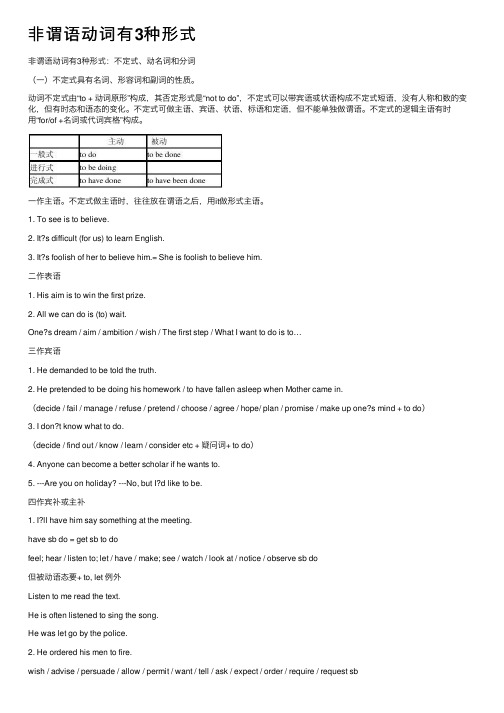
⾮谓语动词有3种形式⾮谓语动词有3种形式:不定式、动名词和分词(⼀)不定式具有名词、形容词和副词的性质。
动词不定式由“to + 动词原形”构成,其否定形式是“not to do”,不定式可以带宾语或状语构成不定式短语,没有⼈称和数的变化,但有时态和语态的变化。
不定式可做主语、宾语、状语、标语和定语,但不能单独做谓语。
不定式的逻辑主语有时⽤“for/of +名词或代词宾格”构成。
⼀作主语。
不定式做主语时,往往放在谓语之后,⽤it做形式主语。
1. To see is to believe.2. It?s difficult (for us) to learn English.3. It?s foolish of her to believe him.= She is foolish to believe him.⼆作表语1. His aim is to win the first prize.2. All we can do is (to) wait.One?s dream / aim / ambition / wish / The first step / What I want to do is to…三作宾语1. He demanded to be told the truth.2. He pretended to be doing his homework / to have fallen asleep when Mother came in.(decide / fail / manage / refuse / pretend / choose / agree / hope/ plan / promise / make up one?s mind + to do)3. I don?t know what to do.(decide / find out / know / learn / consider etc + 疑问词+ to do)4. Anyone can become a better scholar if he wants to.5. ---Are you on holiday? ---No, but I?d like to be.四作宾补或主补1. I?ll have him say something at the meeting.have sb do = get sb to dofeel; hear / listen to; let / have / make; see / watch / look at / notice / observe sb do但被动语态要+ to, let 例外Listen to me read the text.He is often listened to sing the song.He was let go by the police.to dosuggest / hope / agree / demand / arrange sb to do3. He is said to be doing the work of next year.It?s said that he is doing the work of next year.sb + seem / appear / happen / be said / be reported / be known /be found / be believed + to do / to be doing / to have ( been) doneIt + seem / appear / happen / be said … / be believe that….六作定语1. I have a lot of work to do / no pen to write with.2. the first to come / to be awarded the Nobel Prize3. the last person to do such a thing 最不愿意做…的⼈4. the house to be built next year⽐较: the house being built now / build last year注意(1)做定语的不定式如果是不及物动词,或者不定式所修饰的名词或代词是不定式动作的地点、⼯具等,不定式后应有相应的介词。
非谓语动词(3)—现在分词
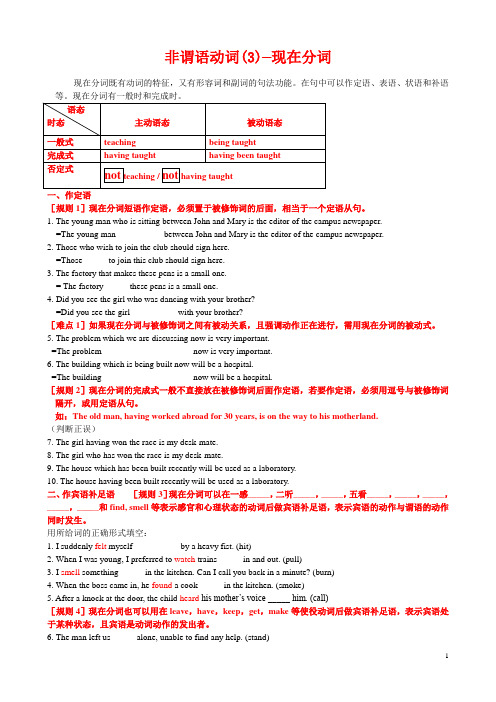
非谓语动词(3)—现在分词现在分词既有动词的特征,又有形容词和副词的句法功能。
在句中可以作定语、表语、状语和补语一、作定语[规则1]现在分词短语作定语,必须置于被修饰词的后面,相当于一个定语从句。
1. The young man who is sitting between John and Mary is the editor of the campus newspaper.=The young man __________ between John and Mary is the editor of the campus newspaper.2. Those who wish to join the club should sign here.=Those _____ to join this club should sign here.3. The factory that makes these pens is a small one.= The factory _____ these pens is a small one.4. Did you see the girl who was dancing with your brother?=Did you see the girl __________ with your brother?[难点1]如果现在分词与被修饰词之间有被动关系,且强调动作正在进行,需用现在分词的被动式。
5. The problem which we are discussing now is very important.=The problem ____________________ now is very important.6. The building which is being built now will be a hospital.=The building ____________________ now will be a hospital.[规则2]现在分词的完成式一般不直接放在被修饰词后面作定语,若要作定语,必须用逗号与被修饰词隔开,或用定语从句。
动词的非谓语形式有三种
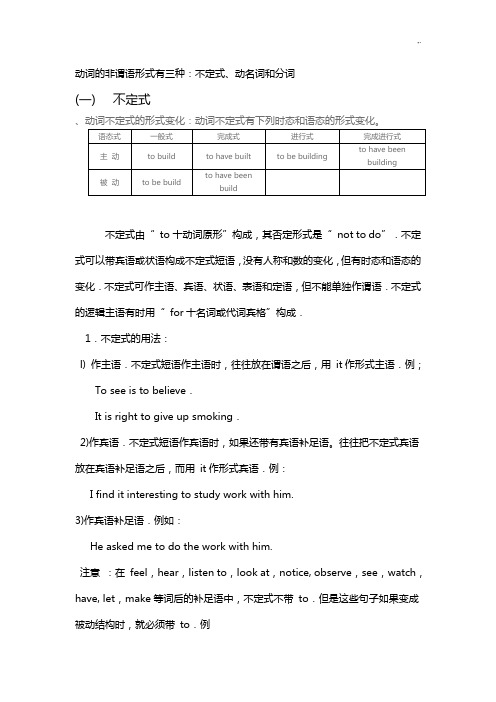
动词的非谓语形式有三种:不定式、动名词和分词(一)不定式不定式由“to十动词原形”构成,其否定形式是“not to do”.不定式可以带宾语或状语构成不定式短语,没有人称和数的变化,但有时态和语态的变化.不定式可作主语、宾语、状语、表语和定语,但不能单独作谓语.不定式的逻辑主语有时用“for十名词或代词宾格”构成.1.不定式的用法:l) 作主语.不定式短语作主语时,往往放在谓语之后,用it作形式主语.例;To see is to believe.It is right to give up smoking.2)作宾语.不定式短语作宾语时,如果还带有宾语补足语。
往往把不定式宾语放在宾语补足语之后,而用it作形式宾语.例:I find it interesting to study work with him.3)作宾语补足语.例如:He asked me to do the work with him.注意:在feel,hear,listen to,look at,notice, observe,see,watch,have, let,make等词后的补足语中,不定式不带to.但是这些句子如果变成被动结构时,就必须带to.例I often hear him sing the song.He is often heard to sing the song.注意:不定式动词在介词but,except,besides后面时,如果这些介词之前有行为动词do的各种形式,这些介词后的不定式不带to,否则要带to.如:She could do nothing but cry.What do you like to do besides swim?I have no choice but to go.4)作定语.例如:I have some books for you to read.注①作定语的不定式如果是不及物动词,或者不定式所修饰的名词或代词是不定式动作的地点、工具等,不定式后面须有相应的介词.例如:He is looking for a room to live in.There is nothing to worry about.Please give me a knife to cut with.但是,不定式所修饰的名词如果是time,place或way,不定式后面的介词习惯上要省去.例如:He had no money and no place to live.注②当作定语的不定式所修饰的名词或代词是不定式动作的承受者时,不定式既可以用主动语态,也可用被动语态,但其含义有所不同.试比较:A) Have you anything to send? 你有什么东西要寄吗?B) Have you anything to be sent? 你有什么要(我或别人)寄的东西吗?(不定式to be sent的动作执行者是已被省略的me或someone else)5)作状语,表示目的、原因、结果或条件.例如:I came here to see you.(目的)We were very excited to hear the news.(原因)He hurried to the school to find nobody there.(结果)To look at him, you would like him.(条件)目的状语还可以用in order to或so as to来表示.如:In order to pass the exam, he worked very hard.We ran all the way so as not to be late.不定式也可在作表语用的形容词后面作状语.例如:I am very glad to hear it.The question is difficult to answer.“too十形容词或副词十不定式”作状语.例如:He is too old to do that.另外句子中有enough这个词时,常用不定式作状语.例如:The room is big enough to hold us.6)作表语.例:My job is to help the patient.7)作独立成分.例;To tell the truth,I don’t agree with you.8)不定式与疑问词who,which,when,where,how,what等连用,在句中起名词作用,可充当主语、表语、宾语等.例如:He didn’t know what to say.(宾语)How to solve the problem is very important.(主语)My question is when to start. (表语)注意:在与why连用时,只用于why或why not开头的简短疑问句中,后面紧跟的动词不定式不带to. 例如:Why not have a rest?9)不定式在句中用主动式还是被动式。
高中英语非谓语动词to do(三)

The room was quite dark inside, so he made some candles to give light.(candles做了to give light的动作,是不定式的逻辑主语)注意:1)如果不定式所修饰的名词是time, place或way,不定式后面习惯上要省略介词。
He had no money and no place to live.2)不定式所修饰的名词或代词是不定式动作的承受者时,不定式既可用主动语态,又可用被动语态,但含义不同。
如果修饰名词的不定式的动作是主语做的, 不定式用主动语态。
试比较:•Have you anything to send?•Have you anything to be sent?3)不定式作定语多表示将来,而动词-ing形式表示正在进行或用途,过去分词则表示已经完成和被动。
a problem to be discussed tomorrow 明天要讨论的问题a problem being discussed now 现在正讨论的问题a problem discussed for thousands of years 已讨论多年的问题6.作状语A. 作修饰动词的目的状语They ran over to welcome the students.注意:不定式表示目的时前面可以加in order 或so as已示强调。
B. 作修饰动词的结果状语1)不定式作结果状语常表示一种事先没有预料到的情况或结果,放在被修饰动词的后面。
What have I said to make you so angry?2)有时为了进一步加强意料不到的语气,在表示结果的不定式前还可加only。
I went to see him only to find him out.7.动词不定式常用句型:(1) It takes / took / will take sb. some time / money to do sth.某人花/花了/将花多长时间/多少钱做某事. 例句:It took me years of hard work to speak good English.(2) It is + adj +for/of sb to do sth。
三级英语语法 非谓语动词复习
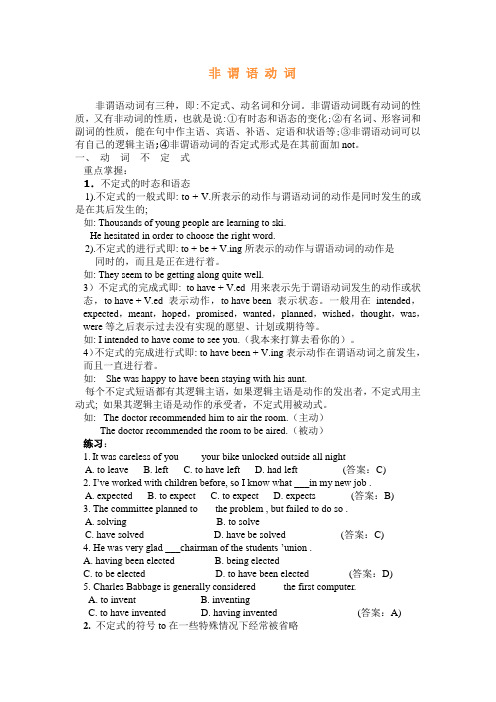
非谓语动词非谓语动词有三种,即:不定式、动名词和分词。
非谓语动词既有动词的性质,又有非动词的性质,也就是说:①有时态和语态的变化;②有名词、形容词和副词的性质,能在句中作主语、宾语、补语、定语和状语等;③非谓语动词可以有自己的逻辑主语;④非谓语动词的否定式形式是在其前面加not。
一、动词不定式重点掌握:1.不定式的时态和语态1).不定式的一般式即: to + V.所表示的动作与谓语动词的动作是同时发生的或是在其后发生的;如: Thousands of young people are learning to ski.He hesitated in order to choose the right word.2).不定式的进行式即: to + be + V.ing所表示的动作与谓语动词的动作是同时的,而且是正在进行着。
如: They seem to be getting along quite well.3)不定式的完成式即: to have + V.ed用来表示先于谓语动词发生的动作或状态,to have + V.ed表示动作,to have been表示状态。
一般用在intended,expected,meant,hoped,promised,wanted,planned,wished,thought,was,were等之后表示过去没有实现的愿望、计划或期待等。
如: I intended to have come to see you.(我本来打算去看你的)。
4)不定式的完成进行式即: to have been + V.ing表示动作在谓语动词之前发生,而且一直进行着。
如: She was happy to have been staying with his aunt.每个不定式短语都有其逻辑主语,如果逻辑主语是动作的发出者,不定式用主动式; 如果其逻辑主语是动作的承受者,不定式用被动式。
非谓语动词一览表
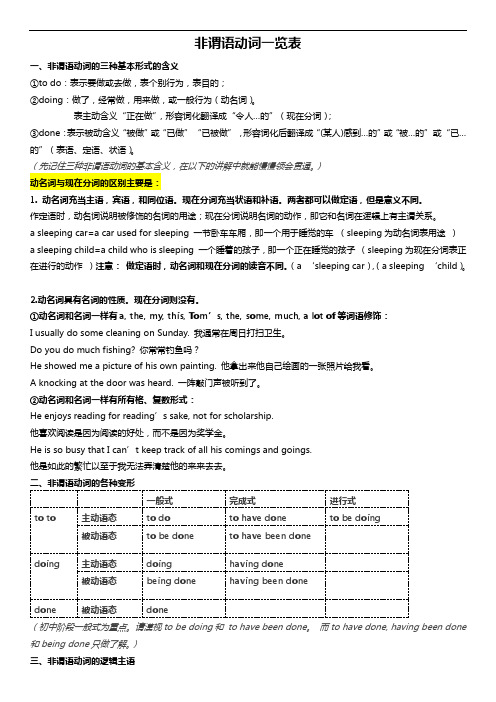
非谓语动词一览表一、非谓语动词的三种基本形式的含义①to do:表示要做或去做,表个别行为,表目的;②doing:做了,经常做,用来做,或一般行为(动名词)。
表主动含义“正在做”,形容词化翻译成“令人…的”(现在分词);③done:表示被动含义“被做”或“已做”“已被做”,形容词化后翻译成“(某人)感到…的”或“被…的”或“已…的”(表语、定语、状语)。
(先记住三种非谓语动词的基本含义,在以下的讲解中就能慢慢领会贯通。
)动名词与现在分词的区别主要是:1. 动名词充当主语,宾语,和同位语。
现在分词充当状语和补语。
两者都可以做定语,但是意义不同。
作定语时,动名词说明被修饰的名词的用途;现在分词说明名词的动作,即它和名词在逻辑上有主谓关系。
a sleeping car=a car used for sleeping 一节卧车车厢,即一个用于睡觉的车(sleeping为动名词表用途)a sleeping child=a child who is sleeping 一个睡着的孩子,即一个正在睡觉的孩子(sleeping为现在分词表正在进行的动作)注意:做定语时,动名词和现在分词的读音不同。
(a ‘sleeping car),(a sleeping ‘child)。
2.动名词具有名词的性质。
现在分词则没有。
①动名词和名词一样有a, the, my, this, Tom’s, the, some, much, a lot of等词语修饰:I usually do some cleaning on Sunday. 我通常在周日打扫卫生。
Do you do much fishing? 你常常钓鱼吗?He showed me a picture of his own painting. 他拿出来他自己绘画的一张照片给我看。
A knocking at the door was heard. 一阵敲门声被听到了。
②动名词和名词一样有所有格、复数形式:He enjoys reading for reading’s sake, not for scholarship.他喜欢阅读是因为阅读的好处,而不是因为奖学金。
动词的非谓语形式

动词的非谓语形式动词的非谓语形式:动词不做谓语时的固定形式。
(1) 动词的非谓语形式包括动词不定式、动名词和分词三种形式;其中分词又包含现在分词和过去分词两种形式。
它们在句子中不能单独作谓语。
(2) 动词不定式:①形式:动词不定式基本形式由“不定式记号to+动词原形”构成。
它的否定形式只要在“to” 前面加上“not”。
它的疑问形式是:“wh-疑问词+to+动词原形”。
*它的被动形式:“to be +过去分词”。
*它的完成形式:“to have +过去分词”。
②动词不定式具有名词、形容词和副词的特征,即可以在句子中作主语、宾语、定语、状语、表语和宾语补足语。
但不定式也保留动词的某些特征,即不定式后面可以跟宾语、表语和状语。
动词不定式加上相关成分就构成不定式短语。
③动词不定式可以放在谓语前句子作主语。
但是通常将作主语的动词不定式或不定式短语放在谓语后面,而在主语位置用“it”作形式主语(有时在不定式的前面还会用for sb.表示不定式的逻辑主语)。
如:To help animals is helping people.(帮助动物就是帮助人)/ It is verydifficult (for us) to learn Chinese well.((对于我们而言)学好汉语是非常的困难)/ It took me half an hour to work out this problem.(解出这道题花了我一个小时的时间)④动词不定式可以作谓语动词(及物动词)的宾语。
[A] 及物动词+不定式一般形式:如:I would like to have a rest at the moment.(我现在想休息一下)/ They began to search the room for the thief.(他们开始在屋子里搜寻小偷)/ He liked to have a swim in the pool near his house.(他喜爱在靠家的水塘里面游泳)/ When did you learn to speak English?(你什么时候开始学英语的?)/ Don’t forget to close the door when you leave.(你离开时别忘了关门)[比较] He forgot to turn off the light.(他忘了关灯.) (没关)/ He forgot turning off the light.(他忘记关过灯.)(关了) / Please remember to ring me up.(记得给我打电话.)(还没打电话) / I remember calling you yesterday but you forgot.(我记得昨天给你打电话了,但是你忘记了.)(打过电话)[B] 及物动词+疑问词+不定式:如:He does not know which one to take.(他不知道该选哪个)/ Tellme how to get to the station.(告诉我怎么样去火车站)/ She askedme what to do for today’s homework.(她问我今天家庭作业做什么)/ Can you teach me how to search the internet?(你能教我怎样上网吗?)[C] 不定式作宾语而后面又有宾语补足语时,通常用it代替作形式宾语,而不定式则后置。
非谓语动词的常用结构

非谓语动词的常用结构在句子中充当除谓语以外的句子成分的动词形式叫做非谓语动词。
非谓语动词分为三种形式:不定式,动名词和分词(分词包括现在分词和过去分词)。
1)不定式to do2)动名词doing3)分词doing/done否定形式:not +不定式,not + 动名词,not + 现在分词一、不定式1. 不定式做状语----目的He goes to the playground to play basketball with his friends.2. 不定式充当名词功能To see is to believe.3.常用结构want (sb.) to do sth. 想要(某人)做某事would like (sb) to do sth 想要(某人)做某事wish (sb.) to do sth. 希望(某人)做某事agree sb to do sth 同意(某人)做某事tell (sb.)(not) to do sth 吩咐(某人)做某事ask (sb.)(not)to do sth 要求(某人)做某事(注:ask\tell sb. not to do sth. 叫某人不干某事)invite sb to do sth 邀请(某人)做某事plan to do sth. 计划去干某事hope to do sth 希望去干某事decide to do sth. 决定去干某事can`t wait to do sth. 迫不及待地干某事can`t afford to do sth 承受不了做某事It takes\took sb.+时间、金钱to do sth.某人花费时间、金钱去干某事It’s +adj. for sb. to do sth.It’s +adj. of sb. to do sth. 做某事对某人来说是…(假如Sb be adj 通顺就用of ) It’s better /best to do sth. 最好做某事be afraid to do sth 害怕...干...be excited to do sth 对干.、、、感到兴奋4.注意以下句型的互换:1). too…to do sth. 太…而不能…2). so +adj. /adv + that(从句) 如此…以致…3).such +(a/an +adj.)+n.+ that(从句) 如此…以致…4).(not) enough (for sb.) to do sth. (对某人来说)做某事(不)够二. _ing分词:1.动名词做主语,谓语动词为单数.Eating apples is good for your health.2.做为介词的宾语是动名词Thanks for helping me.3.在进行时态中。
非谓语动词(语法复习三)

I have some books for you to read. 我有几本书供给你读。 注①:作定语的不定式如果是不及物动词,或者不定式所 修饰的名词或代词是不定式动作的地点工具等,不定式后 面须有相应的介词。 例如: He is looking for a room to live in . 他在找一个房间住。 There is nothing to worry about. 无什么可担心的。 Please give me a knife to cut with. 请给我把刀子来切东西。 但是,不定式所修饰的名词如果是time,place或way,不 定式后面的介词习惯上要省去。 例如: He had no money and no place to live. 他没钱没地方住
• The room is big enough to hold us.
(6) 作表语 My job is to help the patient. 我的工作是帮助病人。 (7)作独立成分 To tell the truth,I don't agree with you. 说实话,我不同意你的观点。
注意
C. 作简短回答或避免不必要的重复时,
动词不定式常常省去to 后面的动词, 只保留to 。
A:Would you like to come to my party? B: Yes , I’d love to ( come to your party). Mary想用我的自行车,但我叫她别用。
Mary wanted to use my bike, but I asked her not to ( use my bike).
+
+ + +
+
动词的非谓语形式有三种不定式,动名词和分词
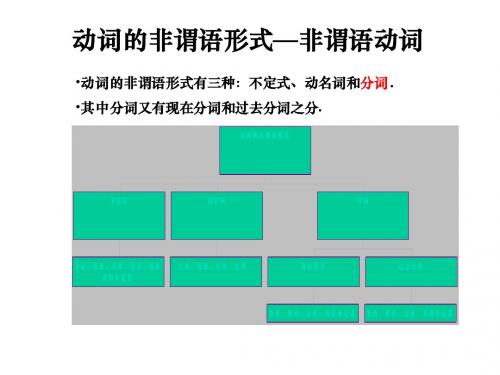
“have +宾语+宾补”的几个句型比较: 注意宾补和宾语的关系!
“have + 宾语+do” 表示让某人做某事 “ have十宾语十doing” 表示主体使客体处于 某状态或一直在干什 么事; “ have十宾语十done” 表示动作是别人做的 或与主体意志无关.
Who would you like to have go with you ?
作状语
• 分词或分词短语作状语时,可以表示时间、原 因、行为方式、伴随状况等。 • 例如: Being a student, I must study hard.(原因) While reading the book, he nodded from time to time.(时间) The teacher stood there surrounded by the students.(方式)
注意:现在分词作定语时,它表示 的动作是正在进行或与谓语动词所表示 的动作几乎同时发生,如果两个动作有 先有后,一般不能用现在分词作定语, 而要用定语从句。
• 例如: The teacher criticizehe window.
分词的用法
• 当分词的逻辑主语与主句的主语不同时:分词必 须有自己的主语. ( 独立结构) 例如: Time permitting, I will finish another lesson.
分词的用法 作表语
• 例如: The news is inspiring. The glass is broken.
•
过去分词表示在谓语动词之前发生的动作,本 身有被动的含义,所以只有一般式没有完成式.
2.分词的用法 • 作定语
分词短语可以作定语代替一个定语从句的作 用。 • 分词短语放在被修饰的名词之后; • 单个分词做定语时,放在被修饰的名词之前. • 例如: The man standing by the window is our teacher. The excited people rushed into the building.
动词的非谓语形式

动词的非谓语形式动词的非谓语形式有三种,即动词不定式,分词(现在分词和过去分词),动名词。
概说我们根据已经学过的语法知识知道,英语中动词有以下几类:助动词,情态动词,连系动词,行为动词(实义动词)。
助动词本身没有词义,不能单独使用,只能起到语法意义上的作用。
情态动词意思不完整,也不能单独使用,必须要和行为动词一起才能构成完整的意思,在句中作谓语。
连系动词作谓语时,后面接形容词和名词等作表语。
行为动词或实义动词在句中常作谓语,根据其后面能否直接带宾语,行为动词又可分为及物动词和不及物动词。
及物动词后面跟名词,代词或相当于名词的词作宾语,不及物动词必须要和一定的介词一起使用才能带宾语。
由上我们可以看出,行为动词在句中常常用做谓语,受主语的人称和数的限制。
但是,动词及其变化形式在句中也可以不作谓语来使用。
据此,我们又可将动词分为限定动词( finite verb )和非限定动词( non-finite verb )两类。
限定动词在句中作谓语,受主语的人称和数的限制,非限定动词在句中不可单独作谓语,不受主语的人称和数的限制,它在句中可以用作其他句子成分。
非限定动词有三种表现形式,既动词不定式,分词和动名词。
我们通常把这三种形式称之为动词的非谓语形式。
动词的非谓语形式或非限定动词在语法意义上具有双重性质:既具有动词性质,又具有非动词性质。
其动词性质表现在(1)有时式和语态的变化(2)可被状语修饰(3)及物动词须有宾语。
其非动词性质表现在(1)相当于名词(2)相当于形容词。
动词的三种非谓语形式与自己的宾语或状语连用就构成非限定动词短语,分别叫做动词不定式短语,分词短语和动名词短语。
动词不定式和动词不定式短语动词不定式在句中可作主语,主语补足语,宾语,宾语补足语,表语,定语,状语等。
动词不定式也有时式和语态的变化。
1.动词不定式作主语(a)To see is to believe.(b)To master a foreign language is of great importance today.(c)To teach is to learn.(d)It is a great honor to talk with you.2.动词不定式作主语补足语(a) He was seen to enter the hall.(b) It is reported to be true.(c)He is said to be from New York.(d)The young man was considered to have great promise.3.动词不定式作宾语(a) He seemed to know the secret.(b) I want to talk with him very much.(c) He liked to live there, However, he found it difficult to get used to the climate.4.动词不定式作宾语补足语(a)He begged me to give him a hand.(b)I would like you to have an opportunity to appreciate Chinese art.(c) I’ll leave you to attend the matter..(d) The boss made these workers work over 12 hours a day.5. 动词不定式作表语(a ) The duties of a postman are to deliver letters and newspapers.(b) My chief purpose has been to point out the difficulties of the matter.(c ) The important thing is to save lives.(d) The only thing I could do was to leave.(e) His wish is to become a doctor.6.动词不定式作定语(a)The next train to arrive was from Beijing.(b)He was always the first to come and the last to leave the office.(c)The four abilities to learn a language are listening, speaking, reading and writing.(d) Our need to communicate with each other has been a driving force in the developmentof technology.7.动词不定式作状语(a)He cupped his ears to hear better.(b)I stayed there to see what would happen.(c ) I come here to see you.(d) To emphasise the woman even more, Chen Yifei adds a lot of detail to the fan and thecloth of her dress.(e)Between 1933and 1940, Xu Beihong held several exhibitions in Asia and Europe topromote Chinese art.上述动词不定式或动词不定式短语在句中作目的状语。
